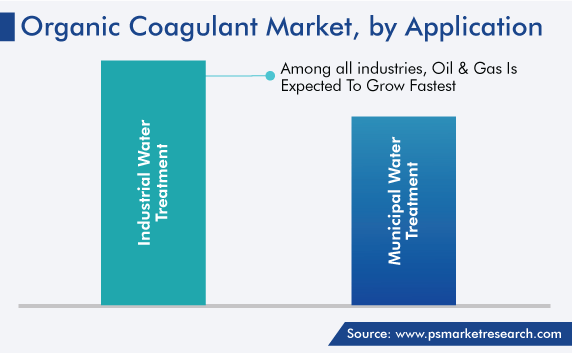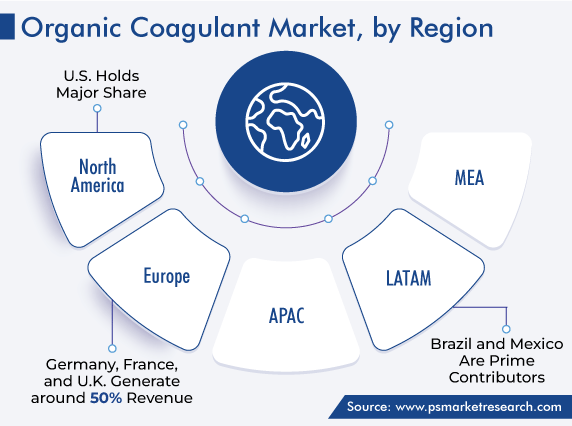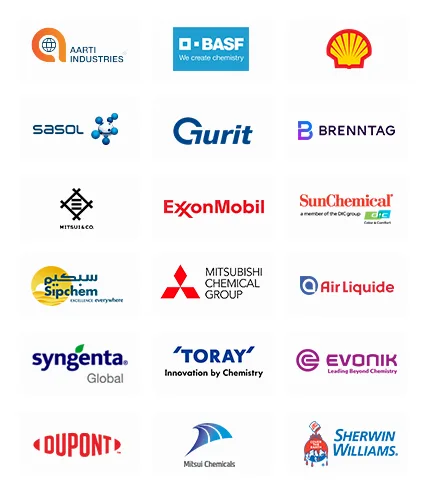Market Statistics
| Study Period | 2019 - 2030 |
| 2024 Market Size | USD 1,987.9 Million |
| 2030 Forecast | USD 3,811.5 Million |
| Growth Rate(CAGR) | 11.5% |
| Largest Region | Asia-Pacific |
| Fastest Growing Region | Asia-Pacific |
| Nature of the Market | Fragmented |
Report Code: 12650
Get a Comprehensive Overview of the Organic Coagulant Market Report Prepared by P&S Intelligence, Segmented by Type (Polyamine, PolyDADMAC), Application (Municipal Water Treatment, Industrial Water Treatment), and Geographic Regions. This Report Provides Insights from 2019 to 2030.
| Study Period | 2019 - 2030 |
| 2024 Market Size | USD 1,987.9 Million |
| 2030 Forecast | USD 3,811.5 Million |
| Growth Rate(CAGR) | 11.5% |
| Largest Region | Asia-Pacific |
| Fastest Growing Region | Asia-Pacific |
| Nature of the Market | Fragmented |

Explore the market potential with our data-driven report
The global organic coagulant market size stood at USD 1,987.9 million in 2024, and it is expected to advance at a compound annual growth rate of 11.5% between 2024 and 2030, to reach USD 3,811.5 million by 2030. This is primarily ascribed to the shortage of drinking and fresh water in the residential and industrial areas, and the growing population and rapid urbanization in developed and undeveloped countries.
Moreover, the demand for this chemical is rapidly growing from several facilities such as sewage treatment, industrial water treatment, chemical fertilizer, food & beverages, and paper & pulp manufacturing. It is used to remove waste, colloidal suspension, and dust particles from the water and make it consumable. The combination of coagulant or flocculant with colloids in wastewater creates broader molecules that settle down on the ground level because of gravity. In addition, chemical compounds such as aluminum salts, iron salts, hydrated lime, aluminum chlorohydrate, poly aluminum chloride, and magnesium carbonate are very much sufficient in decreasing the suspended solid concentrations from water.
Furthermore, the major players operating in this market are more focused on creating nature-friendly and innovative formulations to attain a competitive advantage. The companies also invest in research and development activities to develop green chemicals to gain an edge in the industry.
The rapidly growing population implies a great impact on the demand. The growing population escalating the consumption of clean or drinkable water globally, which needs an advanced purifying process to eliminate impurities and harmful bacteria. Along with this, the rising economy implies a considerable growth impact on the investment for water treatment plants. Hence, governments expand their treatment infrastructure to fulfill the consumption need of the public. Hence, these factors are boosting the demand for organic coagulant because it is an environment-friendly and effective way to purify water.
Additionally, the growing population is increasing the volume of household sewage, which contains several impure contaminants, which should be purified before being dissolved into the environment or river. Coagulants are used for the treatment of sewage water and make the water good and fit for health or reusable for other purposes. Thus, day-by-day increasing needs and awareness among people about the benefits of pure water are broadly escalating the demand for this chemical.

Based on industrial water treatment, the oil and gas category is expected to grow at the highest CAGR, around 10%, in the coming years. The growth can be mainly attributed to the increasing usage of this organic chemical in the oil and gas sector for drilling and extraction of petroleum from the ground, in which gallons of water are required for fracking operations. In the extraction process, water is mixed with the chemical, and their concentrations level and mixture rely on the formation and type of rocks.
In addition, there are two types of water operation in the oil & gas industry. The first one is onshore operation, where water is sourced from a nearby water treatment facility, and the second is offshore operation, in which seawater is used, which needs an advanced filtration process as compared to the normal water treatment plant. This is the key factor boosting the growth of the market in this category.
Moreover, the surging R&D activities in this area drive the demand for organic coagulants. For instance, a group of researchers from the Gas Processing Centre at Qatar University has found the best approach to fulfill the need for eco-friendly materials in wastewater treatment facilities. The research team found several green applications of choline chloride-based natural deep eutectic solvents as an organic coagulant for colloidal suspensions.
The growing population is propelling the demand for treated water, due to which governments have made various policies to monitor and maintain the quality of water. The direct release of harmful chemicals from industries and untreated sewage water into water bodies is another reason leading governments to make strict policies. To maintain the quality of drinking water sources, government regulations such as Urban Waste-Water Treatment Directive (Europe) and the U.S. Environmental Protection Agency have implied strict policies. Thus, this factor is responsible for the growth of the market.
Drive strategic growth with comprehensive market analysis
The APAC market is expected to witness the fastest growth, advancing at a CAGR of 9.5%, during the forecast period. This can be ascribed to the increasing demand for safe and clean water, the growing population, rapid urbanization and industrialization, the presence of strict government regulations, and the rising investments in the development of water treatment plants in the region.
Regional countries, such as India, China, South Korea, and Japan, are accounting for almost half of the market demand. For instance, in India, due to the high population growth, water treatment facilities need to maintain the stability of supply and quality of water to fulfill the demands without affecting people’s health. There are almost 1090 sewage treatment plants in India, and almost in every water plant, this chemical is used for water treatment. In most purifying processes, water cannot be split from coagulation and flocculation whether it is water or wastewater, because it helps eliminate impure contaminates from the water and make it fit for health.

The Middle East & Africa market is expected to grow at a significant growth rate in the next few years. Almost 6% of the global population lives in MEA, which has less than 2% of the world's water resources. This region is the most water scarcity along with the 12 most water-scarce countries, such as Kuwait, Bahrain, Qatar, and the Palestinian Territories. In this region, there are only 1,200 cubic meters of available water, which is six times less than from world's 700 cubic meters availability of water. In the GCC countries, almost 28–67% of water is retreated or reused to fulfill the requirement of fresh water. All of these are the key driving factors escalating the demand for organic coagulants in the region.
Based on Type
Based on Application
Geographical Analysis
The organic coagulant market size stood at USD 1,987.9 million in 2024.
During 2024–2030, the growth rate of the organic coagulant market will be 11.5%.
Industrial water treatment is the largest application area in the organic coagulant market.
The major drivers of the organic coagulant market include the scarcity of water, rapid industrialization and urbanization, the presence of strict government rules, the growing population, and the surging awareness among people about the advantages of pure and fresh water.
Want a report tailored exactly to your business need?
Request CustomizationLeading companies across industries trust us to deliver data-driven insights and innovative solutions for their most critical decisions. From data-driven strategies to actionable insights, we empower the decision-makers who shape industries and define the future. From Fortune 500 companies to innovative startups, we are proud to partner with organisations that drive progress in their industries.


Working with P&S Intelligence and their team was an absolute pleasure – their awareness of timelines and commitment to value greatly contributed to our project's success. Eagerly anticipating future collaborations.
McKinsey & Company
IndiaOur insights into the minutest levels of the markets, including the latest trends and competitive landscape, give you all the answers you need to take your business to new heights
We take a cautious approach to protecting your personal and confidential information. Trust is the strongest bond that connects us and our clients, and trust we build by complying with all international and domestic data protection and privacy laws
Customize the Report to Align with Your Business Objectives
Request the Free Sample Pages